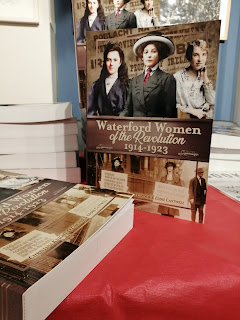By late 1922 and early 1923 the Free State Government were becoming increasingly impatient in curtailing the activity of the Irregulars. Historically, the significance of the input by Cumann na mBan to the conflict enabled the war to continue. There can be no doubt about that! They not only maintained lines of communication but involved themselves in other areas of conflict and, basically, they had to be stopped!
And so began the rounding up and large scale arrests of many leading women. Kilmainham Jail was opened to women from February 1923 until September 1923.
Over that short period there were over 500 women imprisoned in the Jail. The witness statements of the women detail the harrowing treatment of female prisoners during their incarnation in Kilmainham Mountjoy and North Dublin Union.
Many women were initially arrested and imprisoned in their local jails but later transferred to the larger Dublin prisons. The Emergency Powers acts permitted the Military Courts to arrest and detain women without trial with just the signatures of two Officers. While some women were detained for days or weeks; many were incarcerated without trial and for significantly longer periods. Miss Bridget/Biddy Condon of Ballymacarbry, Co Waterford was arrested in her place of work in Clonmel on 7 March and initially imprisoned in Clonmel jail. Biddy had helped establish the Ballymacarbry and Nire Cumann na mBan branches in 1918, alongside Mary Cooney, District President of the 5th Battalion South Tipperary Brigade. Prior to the Civil War the Ballymacarbry branch were under the command of South Tipperary District, despite its location in Waterford County.
After the truce Ballymacarbry branch merged with the Waterford Brigade and Cumann na mBan branch with Dungarvan District Council. In her role as Treasurer of the Ballymacarbry branch, she was involved with intelligence, dispatch work, transporting ammunition, sending parcels to IRA prisoners for both South Tipperary and West Waterford Colum’s. As an Intelligence Officer during the War of Independence, information secured by her led to an important attack on a British military train near Cahir. Like many anti-Treaty Cumann na mBan, her work became more involved and precarious during the Civil War period, despite having to continue working fulltime to support herself. During the occupation of Clonmel Barracks, she was called on to assist each night after work with field dressings and other tasks. The importance of the more hard-line Republican women was well known to the Free State. Imprisoning these women allowed them to curtail the vital support network for the IRA and gain control over the anti-Treaty insurrection. Bridget and Mary were arrested in their place of work and held with other local Cumann na mBan women in Clonmel Jail for several weeks, before they were transferred to Kilmainham Jail in Dublin.
During a nine-month period they were incarcerated without trial and in April/May transferred to North Dublin Union. Both women were released on active hunger strike in considerably poor health on 7 November 1923, just days before the strike officially ended.
On 23 November, the strike officially ended and the remaining female prisoners in the NDU were released in December 1923. When Biddy returned home to Ballymacarbry, Co. Waterford she was in extremely poor health. To add insult to injury she now found herself without a job and therefore had no income. The difficult decision to sell her home was not an option, but a certainty. She took up residence for a time with her brother-in-law and her sister, Mary O’Ryan, Ballymacarbry. Bridget’s brother-in-law, Michael O’Ryan also served a lengthy incarceration during the end of the Civil War and endured a lengthy hunger strike. Biddy was later refused an l military pension and forced to appeal this decision. Mary Cooney died prematurely in 1942 and on 30 April and the same year her brother and next of kin, Seán Cooney was granted a pension from the date of application in 1934 until her death in 1942.
For more about Bridget Condon and many more Waterford women buy your copy of Waterford Women of the Revolution 1914-1923 at Waterford Book Centre, David Walsh’s, Lower Main Street, Dungarvan, Lismore Heritage Centre and Waterford County Museum, 058 45960 or history@waterfordmuseum.ie and also online https://www.waterfordmuseum.ie/revolution/.











